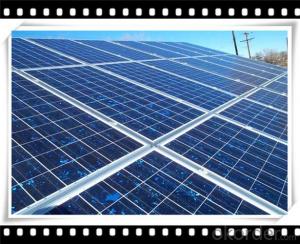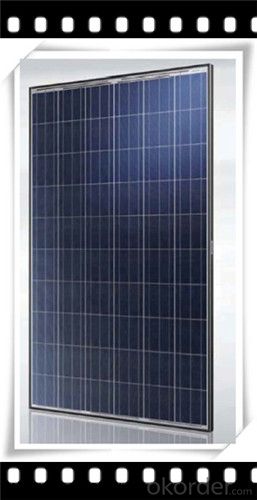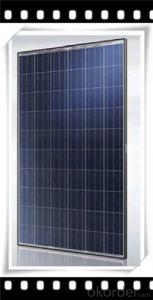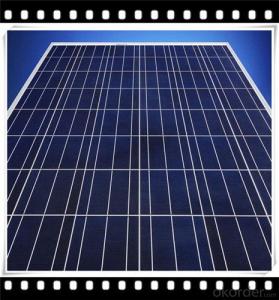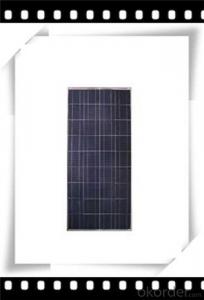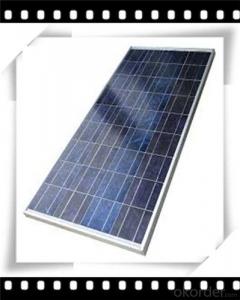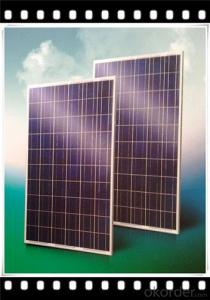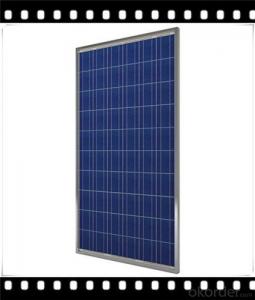Virginia Beach Solar Panels 40w Poly Mini Solar Panel Hot Selling CNBM Solar Panel
- Loading Port:
- Qingdao
- Payment Terms:
- TT OR LC
- Min Order Qty:
- 10 set
- Supply Capability:
- 300000 set/month
OKorder Service Pledge
OKorder Financial Service
You Might Also Like
Polycrystalline Solar Modules
CNBM offers a range of small, medium and large polycrystalline solar modules, designed for a range of requirements.
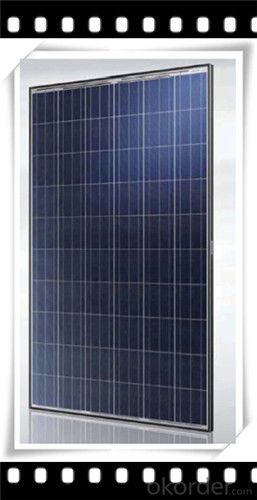
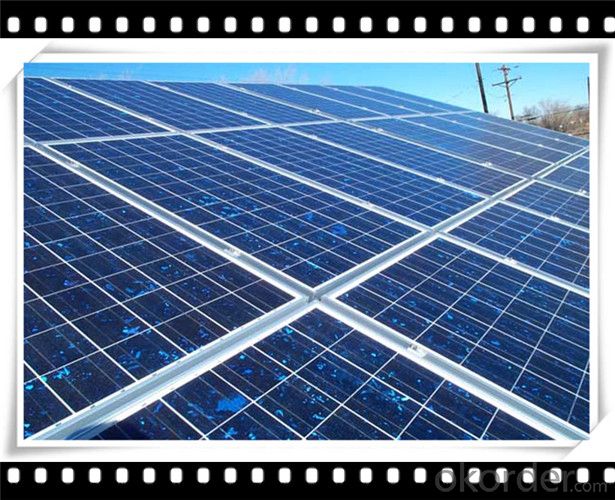
Specifications:
+/-3% |
Polycrystalline silicon solar cells (156 x 156mm) |
60 (10 x 6) |
1650 x 990 x 40 |
25.5 |
Limits:
Operating Temperature | -40~+85? |
Storage Temperature | -40~+85? |
Maximum System Voltage | 1000 VDC max. |
Hail Impact | Diameter of 28mm with impact speed |
Temperature and Coefficients:
NOCT | 48C+/-2? |
Voltage temperature coefficient (%/K) | -0.35 |
Current temperature coefficient (%/K) | 0.05 |
Power temperature coefficient (%/K) | -0.45 |
Characteristics:
Model: | SGM-200P | SGM-210P | SGM-220P |
Max-power voltage Vmp (V) | 29.2 | 29.4 | 29.41 |
Max-power current Imp (A) | 6.85 | 7.14 | 7.48 |
Open-circuit voltage Voc (V) | 36.5 | 36.69 | 36.9 |
Short-Circuit Current Isc (A) | 7.28 | 7.6 | 7.93 |
Max-power Pm(W) | 200 | 210 | 220 |
Model: | SGM-230P |
Max-power voltage Vmp (V) | 29.8 |
Max-power current Imp (A) | 7.72 |
Open-circuit voltage Voc (V) | 37.31 |
Short-Circuit Current Isc (A) | 8.19 |
Max-power Pm(W) | 230 |
STC: Irradiance 1000W/m2, module temperature 25?, AM-=1.5
Poly Crystalline Solar Panels Specifications Range
Maximum Power (Pm) | Dimension | Weight | Operating Voltage (Vmp) | Operating Current (Imp) | Open Circuit Voltage (Voc) | Short Circuit Current (Isc) |
0.45W | 140x80x10mm | 0.08kg | 3.3V | 150mA | 4.6V | 160mA |
1.0W | 162x140x10mm | 0.16kg | 7.5V | 150mA | 10.3V | 160mA |
4.5W | 269x251x23mm | 0.8kg | 16.5V | 0.27A | 20.5V | 0.3A |
10W | 420.1×268.9×22.6mm | 1.92kg | 17.5V | 0.58A | 20.5V | 0.6A |
20W | 425x502x50mm | 3.0kg | 16.8V | 1.19A | 21.0V | 1.29A |
30W | 593x502x22.6mm | 3.9kg | 16.8V | 1.78A | 21.0V | 1.94A |
40W | 655x537x50mm | 5.75kg | 17.3V | 2.31A | 22.1V | 2.54A |
50W | 839x537x50mm | 6.0kg | 17.5V | 2.9A | 21.8V | 3.17A |
65W | 1111x502x50mm | 7.2kg | 17.6V | 3.69A | 22.1V | 3.99A |
80W | 1204x537x50mm | 7.7kg | 17.6V | 4.55A | 22.1V | 4.8A |
- Q: Can solar panels be used for powering construction sites?
- Yes, solar panels can be used to power construction sites. They can provide a reliable and sustainable source of energy to run various equipment and tools used in construction, including lighting, power tools, and machinery. Solar panels can help reduce reliance on traditional fossil fuels, lower energy costs, and minimize the environmental impact of construction activities.
- Q: I am curious about how much of the energy that a solar panel of a given size and capacity will produce in it's lifetime, and what fraction of that energy was required to produce it in the first place?
- The attached link is to an article from the 200 Home Power magazine. In that article the energy payback was found to be between 2 and 4 years. Newer panels are more efficient primarily because the silicon wafers used today are thinner. The silicon cell embodies most of the energy required to make a solar panel. Today most solar panels will produce the amount of energy required to manufacture them in between about 9 months and 2 years depending upon the specific technology used to make it. Solar panels are expected to produce energy for between 30 and 50 years. Therefore it takes around 5% of their total energy production to produce them. Note that these figures depend upon where the panels are installed. Panels in very sunny areas may generate more than 3 times the energy of panels in a cloudier area. Edit - The energy payback meta-study that carbonates references below mention one particular study Alsema (2000), which the authors used as a baseline to come up with their 4 year payback figure. These studies DO NOT assume ideal conditions. The Alsema study assumes an annual an irradiation of 700 kWh/m2/yr. That is the United States average irradiation and does take into account cloudy weather and the like. Under idea conditions the amount of energy collected can be almost twice as much. Albuquerque New Mexico is an example. The figures I mentioned above are recent values reported by several different panel manufacturers with whom I discussed the issue at the 2006 IEEE 4th World Conference on Photovoltaic Energy Conversion held this May. The very long payback times that carbonate highlights are almost certainly wrong. The study he references concludes that paybacks range between 2 and 8 years with 4 years being the most likely. In my opinion payback times are actually a fair bit shorter based on conversations with the manufacturers.
- Q: ASAP :) as much details as possible
- sounds like a homework essay question to me
- Q: Can solar panels be installed on public parks or gardens?
- Yes, solar panels can be installed on public parks or gardens. In fact, installing solar panels in these areas can be a great way to promote renewable energy, reduce carbon emissions, and generate clean electricity to power nearby facilities or feed into the grid. Additionally, solar panels can provide shade for park-goers and enhance the overall sustainability of the space.
- Q: Can I add more solar panel let say up to 200 watt and adding two 2 volts battery using the same charges controller and power inverter?
- If you put a black panel on the ground or on your house and don't connect it to anything, it will absorb solar energy (heat) during daylight and release it at night (radiation). Not exactly. Assuming the black panel establishes an equilibrium temperature, it's going to be losing exactly as much heat as it's receiving during the day. Some will radiate out into space, some will conduct or convect into the atmosphere. As a wild guess, maybe 50/50. If you hook up a solar panel in the same place but hook it up to batteries, charge the batteries during sunlight hours and using that energy to electrically heat the home at night. The panels will absorb solar energy during the day but will convert that to electrical energy in the batteries instead of radiating it back into space at night. The panels are only about 4% efficient, so it's the same situation as the pure black panel for 86% of the energy. The remaining 4% will get stored in the batteries and then converted to heat at night. That heat will eventually leak out of the house and warm up the Earth a tiny bit. I think it's much the same situation either way. With the black panel the energy gets radiated / conducted/convected right away. With the solar panel a small percentage is stored and not so much is radiated, mostly conducted and convected. You're partly right as a black panel is going to radiate more into space than a house. But you're taking about maybe some day about 4% of % of the differening radiation/convection/conduction fraction, of the Earth's surface area. Probably not significant.
- Q: hi,i have 4 solar panels. I can get 9V 400mA when i wired them parallel. The question is: how can i make a regulator circuit to store power into batteries.
- wire them in series parallel to get 8 volts at 200 mA, and that should charge a 2 volt battery. You may want to put in a series diode to prevent the battery from discharging into the panel when the sun is out. At 200 mA, depending on the battery size, you may not need much control, as that low a current will not overcharge a large battery, like a small auto battery. In fact it will take a very long time to charge it. edit: But do i need to add a regulator? If by that you mean a voltage regulator, no, as a solar panel has a high output resistance, and that will limit the current into the battery. If you mean a charge controller, if the battery is small, you may need a charge contoller to avoid overcharging the battery. But that is not a voltage regulator. .
- Q: Can solar panels be installed on billboards?
- Yes, solar panels can be installed on billboards. In fact, it is becoming increasingly common to see billboards equipped with solar panels to harness solar energy and power their lighting systems. This not only reduces the environmental impact of billboard advertising but also helps in promoting renewable energy usage.
- Q: What is the warranty on solar panels?
- The warranty on solar panels typically varies between 10 to 25 years, depending on the manufacturer.
- Q: I'm looking for some advice on hot water solar panels. I'm trying to save some money on electricity. A neighbor has been suggesting solar powered equipment for some time now, and I think he's right. It does save quite a bit of money in the long run. They're kind of expensive though, so I'm looking for cheaper alternatives.
- Solar Power is great. I installed it myself about 2 years ago, and you really do notice the change within the first couple months. Building it yourself is actually pretty tricky without the right resources. Some of the guides don't have enough detailed information that you need when you start putting the project together. I was having a lot of trouble until I stumbled upon a site that was offering some great resources for solar DIY projects. I went ahead and added it to the sources section below. It's great and has everything you would need for putting your own solar projects together, including hot water solar panels. Hope this helps!
- Q: Are there any noise or sound-related issues with solar panels?
- No, solar panels do not produce any noise or sound-related issues as they convert sunlight into electricity silently.
Send your message to us
Virginia Beach Solar Panels 40w Poly Mini Solar Panel Hot Selling CNBM Solar Panel
- Loading Port:
- Qingdao
- Payment Terms:
- TT OR LC
- Min Order Qty:
- 10 set
- Supply Capability:
- 300000 set/month
OKorder Service Pledge
OKorder Financial Service
Similar products
Hot products
Hot Searches
Related keywords
